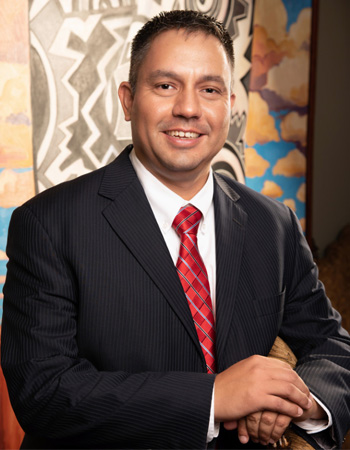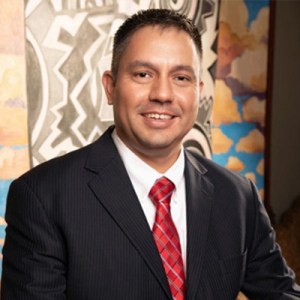Throughout my career, I’ve spent years engaging with Alaska Native, Native American, Native Hawaiian, and Indigenous populations across the country. My experience ranges from helping tribal nations build capacity for climate mitigation and adaptation to providing on-the-ground training and technical assistance to Native businesses.
In doing this work, I’ve been clear that I can’t speak for all Indigenous communities. As a member of the Colville Confederated Tribes, I grew up on one reservation in Washington state. I am not a member of all tribal nations. I’m not part of the Alaska Native population, the Native Hawaiian population, or other Indigenous populations.
But what I’ve learned throughout my experiences thus far is that to support the success of Indigenous communities, it is imperative to meet with, learn from, and engage with as many different communities as possible.
A new role at the SF Fed
This is the mindset I’m bringing to the San Francisco Fed as its Senior Outreach Manager, Tribal and Indigenous Communities—a new role not just for me, but for the Bank.
The Federal Reserve’s Twelfth District is home to 431 federally recognized tribes, which is about three quarters of the country’s 574 tribes. Our District also includes other Indigenous populations, such as those situated in Alaska, Hawai’i, and the Pacific Territories. These numbers speak volumes as to why voices from Alaska Native, Native American, Native Hawaiian, and Indigenous communities are needed for the Federal Reserve’s work to help create an economy that works for all.
The SF Fed has been on a journey to become a community-engaged Bank, placing special importance on directly interacting with and learning from the people we serve. As our SVP of Public Engagement Laura Choi wrote in her essay about public engagement, it is important to listen to learn how different communities experience the economy—including our Indigenous communities—and bring those experiences to our work at the Bank. By doing so we are better able to meet our mission to promote a healthy, inclusive, and sustainable economy.
Our engagement with Alaska Native, Native American, Native Hawaiian, and Indigenous communities, in particular, includes partnering with community leaders, inter-tribal organizations, and certain federal agencies to better understand how these communities are experiencing the economy and to foster greater economic opportunity.
Our top priority: Building trust
We know we have a lot to learn as we begin to build out a more intentional engagement strategy with our Indigenous communities. Essential to this work will be building trust.
The SF Fed has taken the first step to build this trust by creating my position. There’s value in starting the conversation about the relationship we hope to have with tribal and Indigenous communities across our District and dedicating resources to this work.

Now that I’m in this role, my top priority is to continue to build this trust. From my previous experiences, I’ve learned that there are a few key strategies in successfully establishing meaningful relationships, which I’ll be applying to my work moving forward.
- Building trust happens face-to-face. During my time at The National Center for American Indian Enterprise Development and the University of Arizona’s Native Nations Climate Adaptation Program, I saw firsthand the kind of trust that develops with face-to-face interactions. I’ll look to build upon the relationships and capital I’ve already developed through my previous roles to continue this work at the SF Fed by meeting with as many different Alaska Native, Native American, Native Hawaiian, and Indigenous communities as possible, attending different conferences, and engaging with different organizations.
- Consider who isn’t at the table—but should be. I’ve also learned to consider the diversity within Indigenous communities as we build our engagement strategy. It’s important not to miss bringing to the table communities who are smaller, or those without large membership bases or economic revenues, because they are also part of our District and our economy.
- Conversations we begin with the community must continue after we leave the community. It’s easy to drop in for one meeting or event. But our engagement can’t end there. We need to follow up on what we heard and foster the relationship by offering our continued support. That’s how we will build that trust over the long term—and that’s how we can ensure that these invaluable voices become part of the work that we at the SF Fed are doing on issues of economic opportunity, mobility, and participation.
Listening, learning, and sharing
One of the highlights of engaging with tribal nations throughout the country in my previous roles has been to learn about the many success stories and innovations coming from our communities and sharing them with the broader public. At the same time, I think it’s important to look beyond the positive stories, though they’re absolutely needed. With the SF Fed’s platform and resources, we have an opportunity to bring attention to issues that these communities are facing when it comes to accessing economic opportunity.
Alaska Native, Native American, Native Hawaiian, and Indigenous populations have struggled and continue to struggle economically with equitable access to credit, housing affordability, climate risk, and access to child care—issues that disproportionately affect low and moderate-income communities and communities of color across the country. As such, these are the issues that our Community Development team at the SF Fed and other Federal Reserve Banks have been exploring, with direct input from those who live and work in these communities, through research, convenings, and community events.
We’re just building the foundation now, but there’s so much we’re planning to do—and together with my Bank colleagues and community partners, I’m excited to help advance equitable economic opportunity for Indigenous people and communities.
You may also be interested in:
The views expressed here do not necessarily reflect the views of the management of the Federal Reserve Bank of San Francisco or of the Board of Governors of the Federal Reserve System.

